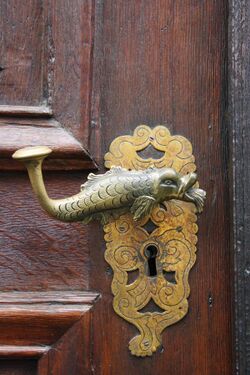Social:Zoomorphism
From HandWiki

The 'Cockerel' diadem, from Calouste Gulbenkian Museum (Lisbon, Portugal), made between 1897 and 1898 by René Lalique

Calligram of a tiger in Arabic script, an example of zoomorphic calligraphy
The word zoomorphism derives from the Greek ζωον (zōon), meaning "animal", and μορφη (morphē), meaning "shape" or "form". It can mean:
- Art that imagines humans as non-human animals[1]
- Art that portrays one species of animal like another species of animal
- Art that creates patterns using animal imagery, or animal style
- Deities depicted in animal form, such as exist in ancient Egyptian religion[2]
- Therianthropy: the ability to shapeshift into animal form[3]
- Attributing animal forms or animal characteristics to other animals, or things other than an animal; similar to but broader than anthropomorphism
- The tendency of viewing human behaviour in terms of the behaviour of animals, contrary to anthropomorphism, which views animal or non-animal behaviour in human terms
Examples
Zoomorphic representation in religion
- The appearance of the Holy Spirit like a dove in the New Testament (The Gospel According to Luke 3: 22), "and the Holy Spirit descended on him in bodily form like a dove..."
- Mark the Evangelist as a lion in later Christian iconography.
- The Egyptian gods were often depicted as zoomorphic or as hybrid
- The names of the two most prominent Hebrew Bible female prophets - Deborah and Huldah - were in the Babylonian Talmud interpreted in zoomorphic terms as "wasp" and "weasel."[4]
Zoomorphic language for things, ideas
- A literary phrase such as "The roar of the ocean".
- Sin lurking like a beast waiting to devour Cain in Genesis.[5]
Humanity portrayed in evolutionary context
Desmond Morris in The Naked Ape and The Human Zoo, Robert Ardrey in African Genesis and Konrad Lorenz in On Aggression all wrote from a sociobiological perspective. They viewed the human species as an animal, subject to the evolutionary law of Survival of the fittest through adaptation to the biophysical environment.[6]
Other
- Fenrisulfr, a wolf in Norse mythology
- Airavata, the king god of elephants in Indian mythology.
- Paw feet bathtub, with feet in the shape of a lion's paws
- The sphinx from the "Oedipus Rex" by Sophocles
- Elephantine Colossus, a hotel
- In The Flintstones and Night at the Museum, the dinosaurs Dino and "Rexy" behave and vocalize like dogs.
- Aslan in The Lion, the Witch and the Wardrobe is a lion that is the king of Narnia
- Robotic pets, like AIBO, modeled on dogs or other animals
- In 2010 city planners from Southern Sudan, which would become independent a year later, unveiled plans for the city center of its capital, Juba, to be built in the shape of a rhinoceros. The city of Wau was to be transformed in the shape of a giraffe.[7]
See also
- Amity-enmity complex
References
- ↑ Hope B. Werness, The Continuum Encyclopedia of Animal Symbolism in Art, Continuum International Publishing Group, 2004, px. ISBN:0-8264-1525-3
- ↑ Simson R Najovits, Egypt, Trunk of the Tree: A Modern Survey of an Ancient Land, Algora Publishing, 2004, p 279. ISBN:0-87586-201-2
- ↑ Gerina Dunwich, Wicca A to Z: A Modern Witch's Encyclopedia, Kensington Pub Corp, 1998, p 155. ISBN:0-8065-1930-4
- ↑ Blaženka Scheuer; Animal Names for Hebrew Bible Female Prophets, Literature and Theology, Volume 31, Issue 4, 1 December 2017, Pages 455–471, https://doi.org/10.1093/litthe/frx032
- ↑ Synthesis: bulletin du Comité national de littérature comparée / Comitetul Național pentru Literatură Comparată, Institutul de Istorie și Teorie Literară "G. Călinescu." - 2002 "Sin is personified as (an animal?) which "crouches" at the door of Cain (Gen 4:7). As Gerhard von Rad (Genesis, 105) remarks, 'The comparison of sin with a beast of prey lying before the door is strange, as is the purely decorative use "
- ↑ William Ickes, Compatible and Incompatible Relationships, Springer Verlag, 1985, p.26
- ↑ Howden, Daniel (2010-08-19). "Turn left at the horn: 'Rhino City' revealed - Daniel Howden, ''9 August 2010''. The Independent". Independent.co.uk. https://www.independent.co.uk/news/world/africa/turn-left-at-the-horn-rhino-city-revealed-2056321.html. Retrieved 2014-03-14.
 |


